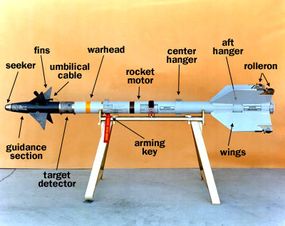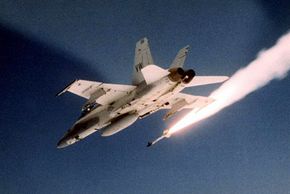The Components
As we saw in the last section, the central idea of the Sidewinder system is to home in on the heat, or infrared energy, from an enemy aircraft (from the engine exhaust or from the hot fuselage itself). Essentially, the missile's job is to keep flying toward the infrared energy until it reaches the target. Then the missile blows up, destroying the enemy aircraft.
To do all of this, the Sidewinder needs nine major components:
Advertisement
- The rocket motor, which provides the thrust to propel the missile through the air
- The rear stabilizing wings, which provide the necessary lift to keep the missile aloft
- The seeker, which sees the infrared light from the target
- The guidance control electronics, which process the information from the seeker and calculate the proper course for the missile
- The control actuation section, which adjusts flight fins near the nose of the missile based on instructions from the guidance electronics
- The flight fins themselves, which steer the missiles through the air -- just like the flaps on an airplane wing, the moving flight fins generate drag (increase wind resistance) on one side of the missile, causing it to turn in that direction.
- The warhead, the explosive device that actually destroys the enemy aircraft
- A fuze system that sets the warhead off when the missile reaches the target
- A battery to provide power to the onboard electronics

Photo courtesy U.S. Department of Defense
